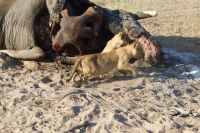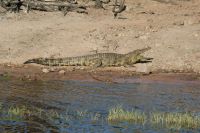Some of you are old enough to remember Pete Seger and the Weavers. I know I am. I remember seeing them sing at the old Roosevelt Auditorium at a benefit hosted by Studs Terkel for the striking coal miners in Kentucky. I remember telling Carolyn, “Half the audience is FBI,” because both Seger and the Weavers were on the list of suspected Communist sympathizers in the 1960s because they sang about social justice.
One of their songs, “Wimoweh,” haunts me today, because it purports to be a song about Africa—“The Lion Sleeps Tonight.” Well, I know at least one lion who will be sleeping well tonight, or certainly well fed, because on our  morning game drive in Chobe National Park we came upon an unusual sight—3 lionesses and 2 cubs feasting on a downed elephant. By the time we got there, the real delicacy, the trunk, was gone, and mom and two cubs were tearing at the carcass. I was a little surprised that with all the impalas in the park (and we saw lots of them and other animals) the lions had gone after an elephant. I suppose that proves who is really king of the jungle. As I said, the park borders the river, and thus offers a little different animal environment than the drier environs I saw at Sabi-Sabi, which is almost south of here. I’m sure those lions will sleep well tonight, or at least well-fed. We’ll be back in the morning to see whether the scavengers in the food chain—the hyenas, jackals, and vultures—will be there, or whether the lions will still be feeding.
morning game drive in Chobe National Park we came upon an unusual sight—3 lionesses and 2 cubs feasting on a downed elephant. By the time we got there, the real delicacy, the trunk, was gone, and mom and two cubs were tearing at the carcass. I was a little surprised that with all the impalas in the park (and we saw lots of them and other animals) the lions had gone after an elephant. I suppose that proves who is really king of the jungle. As I said, the park borders the river, and thus offers a little different animal environment than the drier environs I saw at Sabi-Sabi, which is almost south of here. I’m sure those lions will sleep well tonight, or at least well-fed. We’ll be back in the morning to see whether the scavengers in the food chain—the hyenas, jackals, and vultures—will be there, or whether the lions will still be feeding.
Ironically, our dinner speaker was a woman who heads a Non Government Organization called Elephants Without Borders, which has gotten a grant from Paul Allen (a Microsoft founder) to survey the animal population in Africa. While much of our discussion focused on poaching, the real problem for animals in Africa involves habitat fragmentation. These are animals that need room to roam, and she noted we’ve closed off many of their routes. In other words, as I suggested to her, the problem is not wildlife management, but people management. As the lions discovered this morning, they did help solve any surplus elephant population for a long time.
This morning, a number of us crossed the Chobe River into Namibia (which I knew sort of from philately as German Southwest Africa), making country number 4 that I’ve visited in southern Africa. Our goal was to visit a local village, and to get there, we had to migrate out of Botswana, take a ferry into Namibia, then go through customs/immigration to get to the village which is on an island. According to our guide, about 2,000 people live on the island, which is bereft of electricity, water, and sanitation (“we use the bush,” said the guide; “only old people use latrines,” he told us). There were 48 villages on the island; ours was named Kubufu, which means “maize,” which grew on the island. At one time, the story goes, there were also lots of black mambas on the island, a deadly snake, but when the villagers dispatched them, they killed a python as well, and put that above the village because the python is the king of snakes, and warns others away. You better believe I kept an eye peeled on the road.
We visited one house, which belonged to the village chief, who near as I can tell, controls the village. His permission had to be given to build the immigration point—a relatively modern building that has a modern toilet, as I found out.
Most houses were built of mud, with the final layer hand smoothed termite soil, which is very durable (hope the termites don’t make the journey), fashioned around a wooden frame structure. If you want to get married (I already am), you tell your uncle or grandfather, who work out the arrangements, which includes building a house. The house consists of a tall reed fence, which assures some privacy, a one room house for you, with curtains to partition off some rooms, another one room house for guests or children over 7, and a kitchen. The chief’s house was rather attractive, with an unclosed dining area, an outdoor kitchen (cooking is over charcoal or fire), and some solar-generated electricity. All shopping is done across the river in Kasane, the town we’re in.
I chose to take the river safari again in the evening, rather than jouncing overland in the Land Cruisers here. It was a good choice in terms of what we saw, because Botswana has 125,000 elephants, the largest number in the world, and most of them were down by the river—there was one herd of probably 30, and it was great to be close enough to see them wading,  drinking, and throwing sand on themselves. The little ones seemed almost out of Disney cartoons, and I swear one said, “I can fly,” but bear in mind the cruise served adult beverages. There were also crocodiles on the banks, including a 4 meter one with its mouth open (that’s how the animal
drinking, and throwing sand on themselves. The little ones seemed almost out of Disney cartoons, and I swear one said, “I can fly,” but bear in mind the cruise served adult beverages. There were also crocodiles on the banks, including a 4 meter one with its mouth open (that’s how the animal  controls temperature), which made for some great pictures.
controls temperature), which made for some great pictures.
One of the options our tour director’s wife exercised (partly because she had been here before) was to go on a photo safari. It was pricey, but I might have done it had I known. She did an instructional class, a game drive on land, and then a safari cruise. They lent her a camera and lens combination that carried physical education credit—it was a 100-500 mm lens, which needed a tripod. The boat they used had around ten photographers with their mounted cameras looking for all the world like some gunboat out of a bad scout skit, but the pictures I saw were truly professional looking. If ever you come here, at least remember to bring a good camera with a good lens; cell phones won’t do it.
Well, the lion will sleep tonight, and from all I’ve done today, I suspect I will too.
“Wimoweh, wimoweh, wimoweh.”